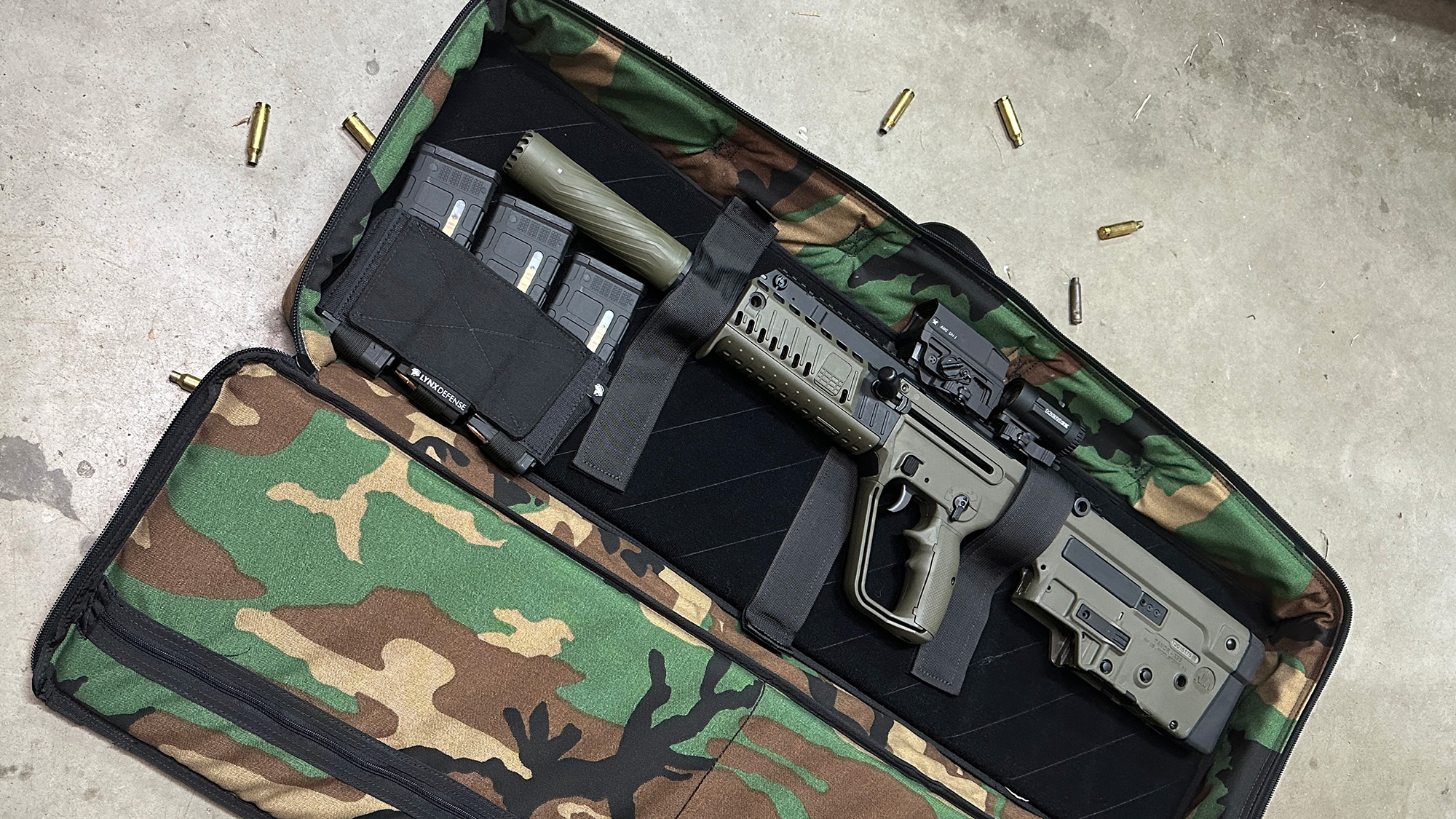
Ready to see what we have coming?
Lynx Defense will release some new things soon. Let us deliver them right to your inbox!

Lynx Defense will release some new things soon. Let us deliver them right to your inbox!

We may earn revenue from product links on this page and participate in affiliate programs. Learn More ›
When Remington went bankrupt, many of their brands came up for auction, and many companies were salivating at the thought of picking up some iconic firearms industry companies, notably some making M16A1s.
One was Harrington & Richarson, an iconic brand in the AR-15/M16 world.
Palmetto State Armory officially purchased H&R, and they wasted no time bringing their iconic guns back to the market.
I got my hands on the classic M16A1 to do a complete, in-depth run down and review so you, the buyer, can make a more informed decision on your next M16 purchase.
Harrington & Richardson (H&R), an American firearms manufacturer, has a history intertwined with U.S. military firearms production, including involvement with the M16A1 rifle.
H&R was founded in 1871 in Worcester, Massachusetts, and over the years, it became known for producing affordable and reliable firearms.
The company had a long history of manufacturing military firearms; for example, during World War II, H&R produced the M1 Garand rifle and the Reising submachine gun for the U.S. military.
The M16 rifle, designed by Eugene Stoner, was first introduced in the late 1950s and early 1960s. It saw extensive use during the Vietnam War.
The M16A1, an improved version of the original M16, was introduced in 1967. It featured several modifications, including a chrome-plated bore, a new rifling twist to stabilize bullets better, and adjustments to the forward assist mechanism.
H&R, along with other manufacturers like Colt (the original designer of the M16), and General Motors’ Hydramatic Division, was contracted by the U.S. government to produce the M16A1 rifles to meet the high demand during the Vietnam War.
This decision to involve multiple manufacturers was typical for large-scale military production, ensuring a steady supply of weapons and mitigating the risk of a single point of failure in the supply chain.
H&R’s production of the M16A1 signified its capability to produce complex, modern military firearms and reflected its role as a significant contributor to the U.S. arms industry.
The company continued to manufacture firearms for civilian and law enforcement markets, but like many historic firearms manufacturers, it experienced various changes in ownership and business challenges over the years.
The involvement of H&R in the production of the M16A1 is part of its broader legacy in the American firearms industry, showcasing its adaptability and capacity to produce critical military equipment during periods of high demand, such as the Vietnam War era.
H&R is now opened by JJE Capital, better known as Palmetto State Armory, and they are breathing life back into this classic firearm and others on the H&R product line.
While the M16A1 shouldn’t be compared to feature sets of today’s modern AR-15 platform, it’s worthy of its classification and consideration for what it is: a firearms icon.
Originally, I thought this grip wasn’t clone correct because it was missing the “bump” in the middle of the grip, which I assume was added for indexing purposes.
However, as Butch in the comments pointed out, this grip is clone-correct for an M16A1 because the bump grip didn’t come along until the M16A2.
I researched this and confirmed that it is, in fact, true. The H&R M16A1 is very clone-correct, even the grip.

Starting with the iconic A1 handguard, the well-known triangle shape that movies have exposed us to. It features milled-out holes on the top and bottom to let the heat from the barrel escape.
Holding the handguard in your hand takes you right into Vietnam. Okay, not really.

I’m not nearly old enough to remember ‘nam.
But it gives me all the Forrest Gump vibes and I know Lt. Dan would L-O-V-E this rifle.

The plastic on the handguard is not textured or extremely thick, which is ideal for someone looking for the best replica of an M16A1.
Like the handguard, the stock is a true-to-form fixed-style buttstock, which is a non-adjustable length of pull and solid.
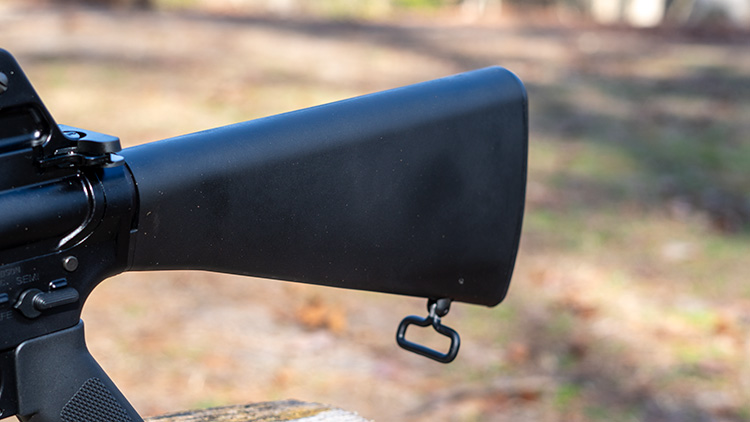
It does feature the sling attachment to run a 1-1.5″ web through. Some M16 options from H&R have the buttstock compartment; however, this model does not.
The stock feels extremely solid and locked up on the gun well.
Nothing says M16 like the A2 carry handle; this is as iconic as it gets to the M16.
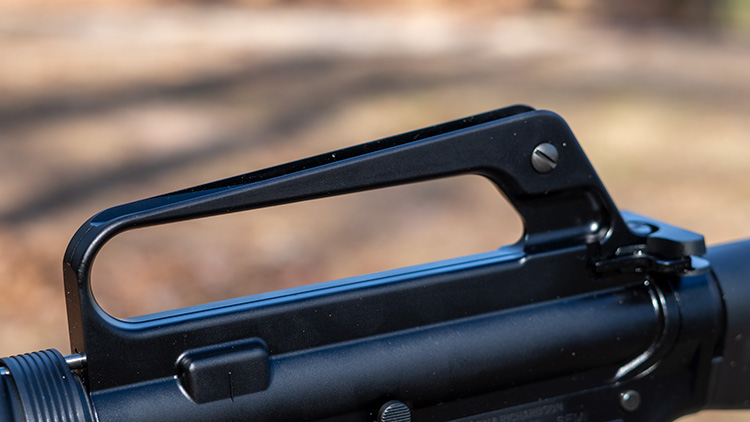
The A2 carry handle is forged into the upper and is one piece. The rear sight is also a part of the carry handle; to me, the carry handle makes the gun feel much thinner overall.
I like the carry handle design and its look and feel while using it for its intended purpose: carrying the gun.
The M16 started the “mil-spec” standard, so I will breeze through these controls because they are as basic as basic gets and are the original mil-spec design for all of these components, which is what you want when buying an M16 clone.
Basic, no-nonsense charging handle. There is no extended grip, no fancy latch, just a bare-bones M16/M4 charging handle without the fluff.
It functions as Eugene Stoner intended and nothing more.
Breezing through these controls, the safety is an AR-15 safety and as standard as it comes.
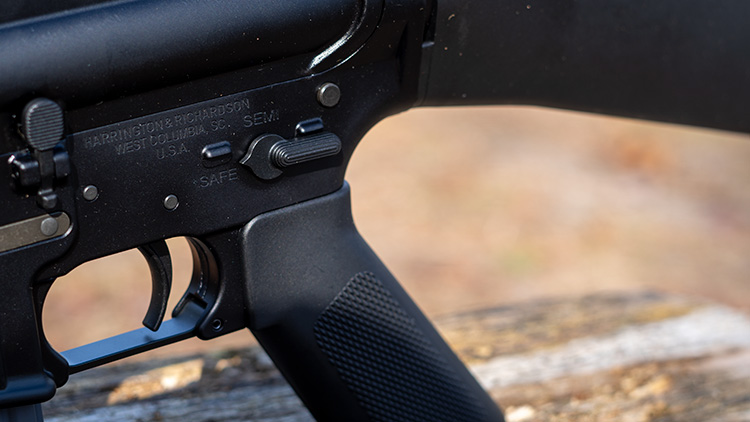
No ambidextrous and very much clone correct. The safety function is excellent and has a 90-degree throw, as expected.
Sticking with the classic controls, the bolt release is the tried and true AR-15 style, but if we want to be technical, its name and nomenclature could be more attributed to the M16 since it was first used on this rifle.
With a mil-spec single-stage trigger, there isn’t much to say that hasn’t been said about AR-15 triggers before.
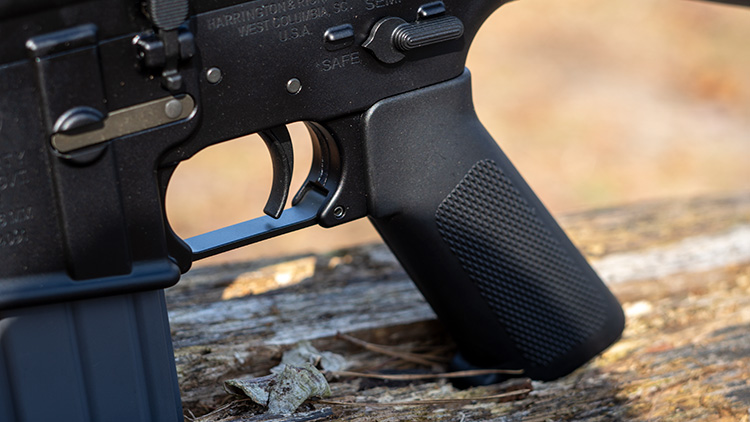
If you want to fancy it up, you can drop whatever trigger you want in this gun, but for what this gun is, I wouldn’t dare water it down with a new trigger.
The break is very clean and crisp with no takeup in the trigger at all.
Getting the H&R to the range was at the top of my priority list as soon as I got this rifle.
The joy I got from the dad joke of walking around talking about having flashbacks to ‘nam (I’m in my 30s, so there’s the joke) is almost immeasurable.
This is the only 5.56 gun I have that has a 20″ barrel, so I was excited to see how that affected the recoil and accuracy of the gun.
First, this gun is a blast to shoot, almost more so than the PSA SABRE-15 and new Gucci ARs. There’s just something about going back in time and shooting a classic like this to understand better where we came from and where we are now.
This gun is a pretty flat shooting gun with almost no muzzle rise. While it has nearly the same recoil impulse as newer AR-15 rifles, it shoots great and is lots of fun.
While the M16 was the OG of the tactical rifle world, it has long been surpassed by modern technology and advancements in small arms.
Usually, I break down the uses for guns into three categories:
Right off the bat, we have ruled out true tactical use, even though it could be. There are so many other options that this is almost literally the last gun on the list, and I’ll explain why in a moment.
This isn’t a hunting gun because the AR-15 isn’t great unless it’s in a different caliber than 5.56.
That brings us to range and our honorable mention category, collector.
This gun is awesome for the range. It’s a fun gun to break out and let shooters feel the nostalgia of the M16 platform. If you want a cool collector gun without breaking the bank to get an original Colt, then this H&R reboot is the way to go.
Since H&R made this with a 5.56 barrel and chamber, you can feed both .223 Remington and 5.56 NATO.
I mostly just buy 5.56 NATO rounds these days, so that’s all I shot through this gun, but since the .223 is a lower-pressure round, you should have no issues.
So, you made it this far, huh? Well, what does this piece of history cost? Well, it depends.
There are plenty of models available, but the one I’m using is an M16A1 “Blem,” so it saves a few bucks and has a few imperfections, which don’t bother me a bit because the one I had in ‘nam wasn’t perfect either /dad joke\.
Brand new, they are around $1,300. You can get just the upper for under $700, but I highly recommend the whole gun.
This would not be my first AR-style gun of choice. This isn’t even my go-to gun now that I have it.
But this gun is one that I’m so glad I have, and I have an absolute blast shooting it on the range. I highly recommend it to anyone looking to get an M16 clone.
Here is a list of some of the most asked questions about H&R and the M16A1 rifles they are producing.
H&R made the M16A1 along with Colt and General Motors during the Vietnam War era but were not the inventors of the M16A1.
It depends on the model and configuration, but the H&R M16A1 in this article is $1,199.99.
H&R was bought and sold many times but is now wholly owned by JJE Capital and is cranking out classic rifles we love left and right!
Harrington and Richardson make their guns, but the company has changed hands several times.
A nice summary of the latest H&R M16A1 clone. But to clarify a couple points:
1. H&R made M1 rifles after the Korean War, not during WWII.
2. H&R did make M14s during the early 1960s, along with TRW, Springfield Armory and Winchester.
3. The “carry handle” is actually A1 style with sights that are not quite as easily adjustable as the A2 style.
4. The H&R M16 clone buttstock does not have a trapdoor, which is correct for this model.
The grip IS correct for the m16a1. The grip with the so called “bump” did not appear until the m16a2.
Thank you for pointing that out! I’ll update the review for accuracy.